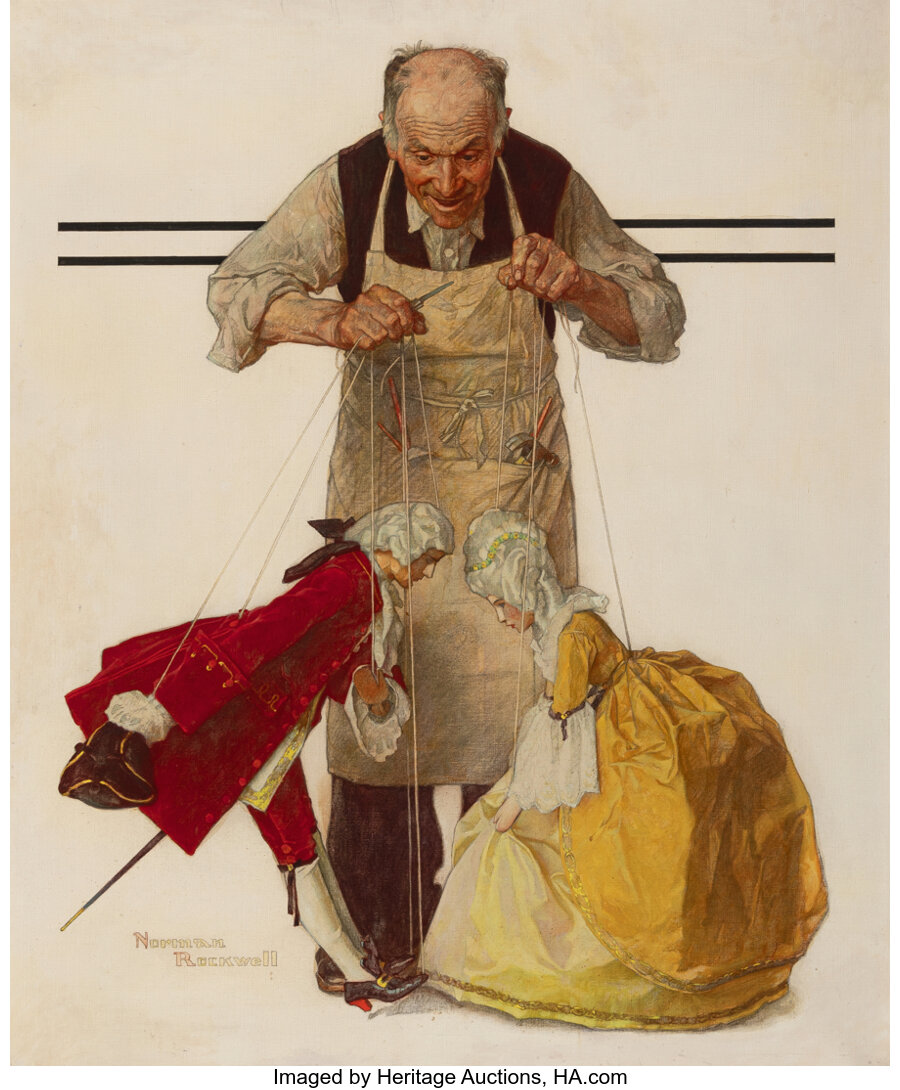Norman Rockwell (American, 1894-1978) Marionettes, The Saturday Evening Post cover, October 22, 1932 Oil on canvas 34 x 28 inches (86.4 x 71.1 cm) Signed lower left: Norman / Rockwell PROVENANCE: Private collection, Northbrook, Illinois, acquired circa 1975. LITERATURE: A.L. Guptil, Norman Rockwell Illustrator, New York, 1946, p. 171, illustrated; M. Moline, Norman Rockwell Encyclopedia: A Chronological Catalog of the Artist's Work 1910-1978, Indianapolis, Indiana, 1979, p. 56, fig. 1-250, illustrated; L.N. Moffatt, Norman Rockwell: A Definitive Catalogue, Vol. 1, Stockbridge, Massachusetts, 1986, p. 123, fig. C330, illustrated. In Marionettes, Norman Rockwell masterfully engages with the themes of performance and control, offering a poignant meditation on the interrelationship between creator and creation. Originally commissioned as a cover illustration for the October 22, 1932 issue of The Saturday Evening Post, this painting exemplifies Rockwell's ability to marry technical precision with emotional nuance. At the center of the composition stands an elderly puppeteer, leaning forward with a mix of intensity and tenderness as he manipulates two eighteenth-century-style marionettes in a theatrical bow. The tension in his gnarled hands mirrors the taut strings of the puppets, subtly suggesting the exertion and delicacy required in the act of storytelling—both literal and artistic. Formally, Rockwell employs a restricted palette of warm tones and controlled shadows to bring out the richness of textures: the puppeteer's worn apron, the satin gleam of the female marionette's gown, the articulated joints of the puppets' wooden limbs. The visual composition is both intimate and performative—emphasizing the small drama enacted by the marionettes while underscoring the larger allegorical themes at play. The bare, off-white background with its minimal, graphic horizontal lines isolates the trio in a nearly theatrical void, directing the viewer's attention solely to their interaction. This compositional decision heightens the symbolism of the moment and places the image in conversation with traditions of genre painting, while simultaneously reflecting the narrative economy required by magazine illustration. The contrast between the humble apron-clad figure and the lavishly attired dolls highlights the interplay of reality and make-believe. Every element is rendered with meticulous realism and warmth: from the wood crossbars and taut strings in the man's hands to the sheen of satin on the marionettes' attire, Rockwell's painterly technique brings each texture and expression to life. This vignette captures a quiet moment of performance, brimming with character and subtle humor, exemplifying Rockwell's ability to infuse everyday scenes with narrative richness. Rockwell's gift for storytelling was always paired with emotional nuance. Marionettes balances humor and heart in a way that makes the viewer "want to sigh and smile at the same time," as Rockwell once said of his artistic aim. Importantly, Marionettes encapsulates a central preoccupation of Rockwell's Depression-era work: the celebration of craftsmanship, labor, and generational wisdom. In an age marked by economic uncertainty, Rockwell's depiction of the solitary artisan working with concentration and devotion resonated deeply with American audiences. The puppeteer's absorbed expression becomes a metaphor for the artist himself—one who pulls the strings behind the scenes to breathe life into inert forms. The emotional intimacy shared between the marionettes, bending in mutual reverence, stands as a testament to the humanity Rockwell could conjure from inanimate figures. While Rockwell has often been labeled a sentimentalist, works like Marionettes reveal a deeper sophistication. Beyond their surface charm, Rockwell's finest paintings invite reflection on the context of their execution, the roles we play, the hands that guide us, and the subtle dance between autonomy and influence. In this painting, Rockwell does not simply illustrate a puppeteer at work; he quietly positions himself as one—inviting viewers into a world where empathy, imagination, and technical mastery converge to form a distinctively American visual lexicon. HID12401132022 © 2024 Heritage Auctions | All Rights Reserved www.HA.com/TexasAuctioneerLicenseNotice



